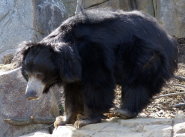 The Sloth bear (Melursus ursinus) has a shaggy, black pelage, long claws which they use for gathering termites/ants. At the chest area, we could see a Y-shaped mark, sometimes it is V-shaped. The Sloth Bear's nostrils could close, and they do this to protect themselves from the dust, or from the insects when they are turning a beehive into lunch. Another facet of this bear: they have a gap in the teeth to allow them to suck up termites or ants.
The Sloth bear (Melursus ursinus) has a shaggy, black pelage, long claws which they use for gathering termites/ants. At the chest area, we could see a Y-shaped mark, sometimes it is V-shaped. The Sloth Bear's nostrils could close, and they do this to protect themselves from the dust, or from the insects when they are turning a beehive into lunch. Another facet of this bear: they have a gap in the teeth to allow them to suck up termites or ants. Sloth Bears, majority of them anyway, are in Sri Lanka and India, but some are living in parts of Nepal. Under the "World Conservation Union's Red List of Threatened Animals", these bears are now "vulnerable", and it could turn into "highly endangered" sooner than later.
A Sloth bear is capable of living in both wet and dry forests, but grasslands are also part of their preferred habitat.
Besides the ants and the termites, the Sloth bear could also go for figs, mangoes, ebony, and some variety of flowers, but the termites and the ants serve as the main constant food source. Other things they eat ar honeycombs, grubs and beetles.
These bears are nocturnal and is rather noisy. It snorts and grunts when it grabs at branches. It also uses its lips in a vacuum-like manner, and I mean a vacuum cleaner. Imagine the noise of an old-and-about-to-be-retired vacuum cleaner and you'll get the idea.
Picture of the sloth bear by Aaron Siirila, licensed under Creative Commons Attribution ShareAlike License v. 2.5
Keywords: nocturnal , brown , black , mane , claw
Which zoos have them?
Brookfield Zoo (United States) and Smithsonian National Zoological Park (United States)The Sloth bear is listed as Vulnerable (VU), considered to be facing a high risk of extinction in the wild, on the IUCN Red List of Threatened Species
Namings for the sloth bear
A young / baby of a sloth bear is called a 'cub'. The females are called 'sow' and males 'boar'. A sloth bear group is called a 'sleuth or sloth'.Sloth bear habitats
Forest, Grassland, Subtropical / Tropical Dry forest and Subtropical / Tropical Dry GrasslandSome facts about the
Sloth bear
Adult weight : 100 kg (220 lbs)
Maximum longevity : 33 years
Female maturity :1095 days
Male maturity : 1095 days
Gestation : 198 days
Weaning : 76 days
Litter size : 2
Interval between litters : 1095 days
Weight at birth : 0.4 kg (0.88 lbs)
Basal metabolic rate : 47 W
Body mass : 66.957 kg (147.3054 lbs)

Custom Search